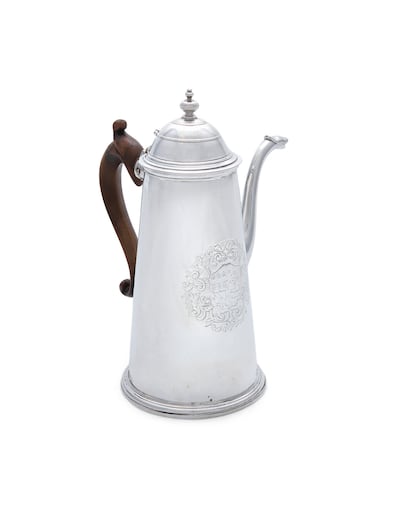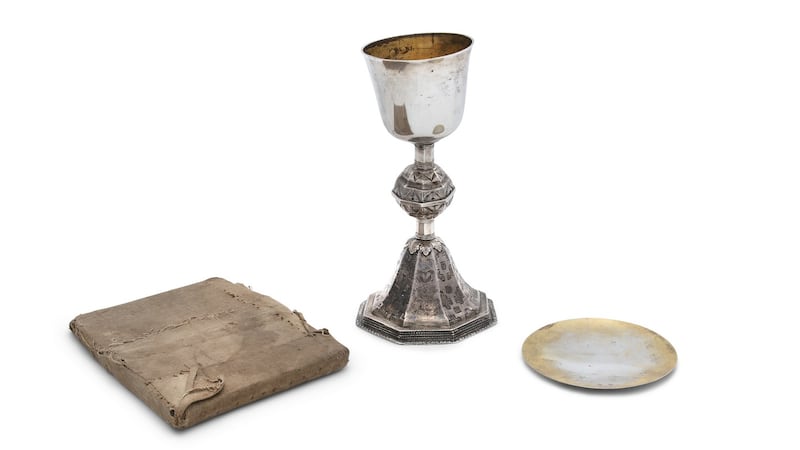A rare Irish William III bleeding bowl dating from 1699 is one of the lots at the forthcoming Adam’s Country House Collection sale at Townley Hall in Co Louth. The annual sale, which includes museum-quality silver and furniture, features about 720 lots in a hefty catalogue published ahead of the October 15th sale.
Bloodletting, or removing blood from a patient, was a treatment used for 3,000 years in an attempt to cure a variety of ailments. Diseases were thought to run in the blood; so removing enough blood helped to remove the malady.
After contracting a sore throat in 1799, George Washington, the first president of the United States, requested of his physician "to be bled". They drained an estimated three litres in less than 16 hours. Despite their best efforts, he died three days later, leading to speculation that excessive blood loss contributed to his demise.
In those days, any doctor worth his salt had a bleeding bowl in his portmanteau, into which he drained the patient’s blood. The origin of the striped barber’s pole is associated with barbers trained specifically to remove blood – along with giving a short back and sides – and many barber-surgeons as they were known, trained at the Royal College of Surgeons in Dublin.
It has been suggested that the Dr Mercer who owned this rare bleeding bowl (€3,000-€4,000), had links to Mary Mercer who established Mercer's Hospital, which is now the medical library for the Royal College of Surgeons.
The Adam's sale also includes objects owned Howe Peter Browne, second marquess of Sligo and governor of Jamaica from 1834-1836, who championed the liberation of slaves on the Caribbean island.
The town of Sligoville on the island is testament to his legacy of emancipation, which he continued right up until 1838 when, after much lobbying, the British government finally announced the immediate liberation of all slaves in the British Empire. This historic legacy of banishing slavery on the Caribbean island is featured in a current exhibition at Browne’s former home, Westport House.
A French Vernis Martin cabinet originally from Westport House is featured in the sale, €12,000-€15,000. Also linked to Browne is a Jamaican specimen work table by Ralph Turnbull, the Scottish furniture maker who lived in Jamaica and was commissioned to create a large suite of furniture for Westport House in the 1800s, (€1,000-€1,500).

As work tables go it would be hard to find a more beautiful specimen than the rare Irish mahogany gentleman’s estate cabinet, or architect’s desk, where panelled doors hide a selection of pigeon holes and folio racks, (€25,000-€35,000).
Other rare pieces include a 600-year-old Spanish games box from the Nasrid kingdom, the last Islamic province of Spain. The piece (€10,000-€15,000) is heavily inlaid with lozenge design and mosaic mother of pearl.
To comprehend the rarity of the Irish George I silver chocolate pot offered in the sale for €25,000-€35,000, you really have to examine the history of chocolate in Europe.

While Christopher Columbus first brought coco beans to Europe from the Americas in the 1500s, Spanish and Dutch sailors threw them overboard thinking they were sheep droppings, and it was not until 1650 that chocolate first reached Britain. It was initially the preserve of the noble classes as it was so heavily taxed, but in 1853 duties were dropped and the luxury beans became available to the wider population.
What makes this chocolate pot interesting is its age: it dates from 1719, when chocolate was scarce all over Europe, and the fact that it is Irish. “You really don’t come across chocolate pots this old, the fact that it is Irish, and would have been a special commission, makes it incredibly rare,” according to James O’ Halloran of Adam’s.

Adam’s has a collection of Catholic altar pieces which includes a silver chalice and paten, along with a penal altar stone and missal, entitled the Stephen Kirwan Chalice, after the benefactor of the chalice in 1718.
The Kirwan family were the oldest of Galway’s 14 tribes, with distinguished family members including Dean Kirwan who was reported to be the first Christian orator of his day. Today, a vineyard in France, Chateau Kirwan produces some fine quality Marguax, made by descendants of the ancestral owners of this ancient silver chalice, €20,000-€30,000.
A further silver offering is a pair of Irish silver sauce boats by John Craig, one of the most important silversmiths of Georgian times. They weigh a whopping 1.13kg – heavier than a bag of sugar each, which explains their estimate of €10,000-€15,000.
For equine lovers, the sale features many pieces of interest from a 19th-century rocking horse, €700-€1,000, to a huge Scottish iron horse trough by Walter McFarlane, €4,000-€6,000, and most interestingly, two equestrian portraits once owned by John Power of Gurteen, MP for Co Waterford from 1837 to 1840.
One of the paintings depicts Valentine, who Power himself rode in the Grand National of 1840. The horse famously jumped over one of the fences hind legs first – while Power managed to stay in the saddle – and today, the ninth jump at Aintree is called Valentine’s Brook after the horse who died two years later.
Along with a second painting of Splendour, both attributed to William Brocas, the lot includes a memento mori of Valentine in the form of the horse's skull. €15,000-€20,000.
See adams.ie and westporthouse.ie.



















